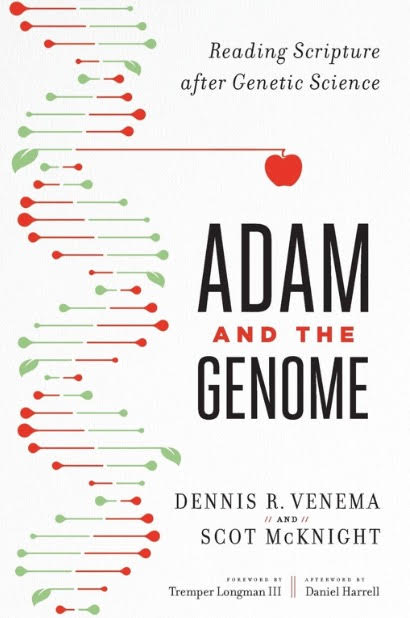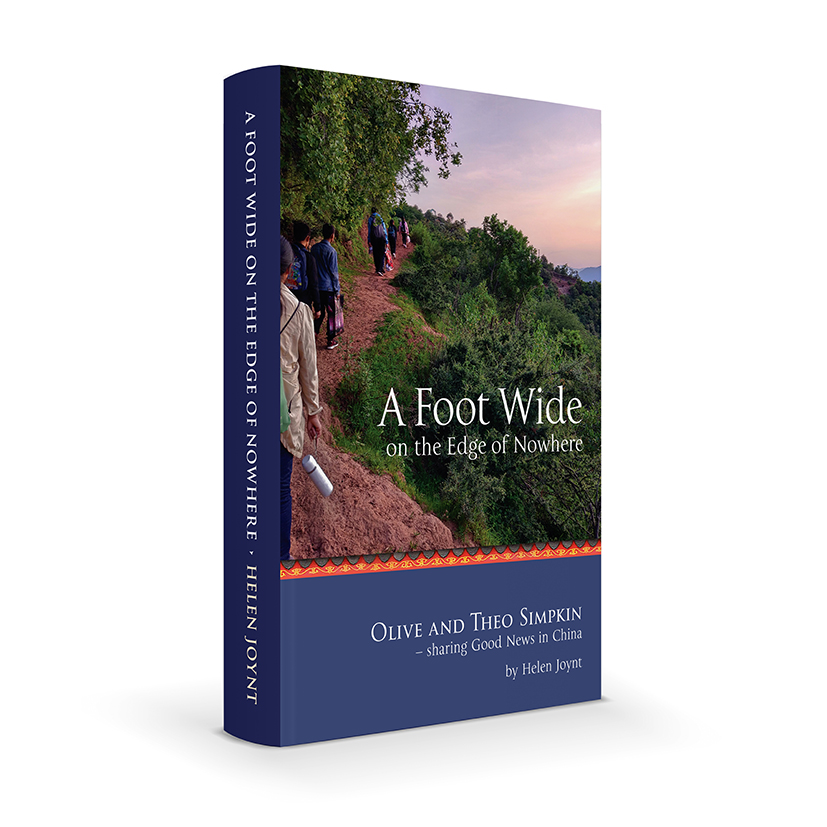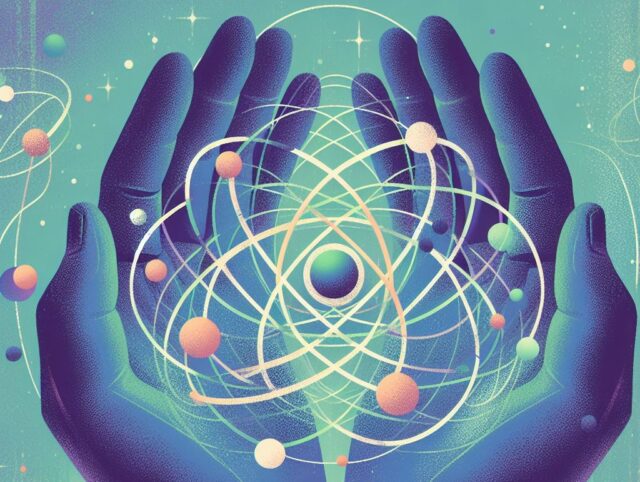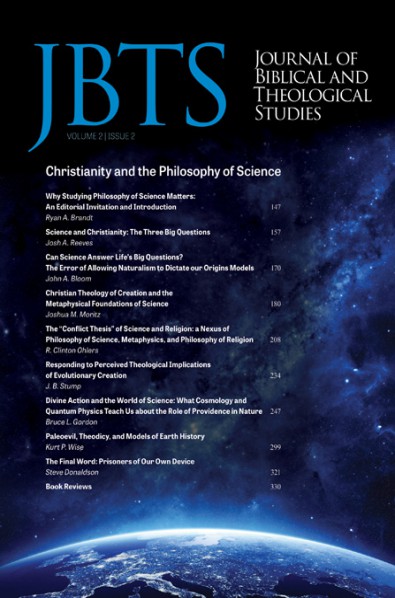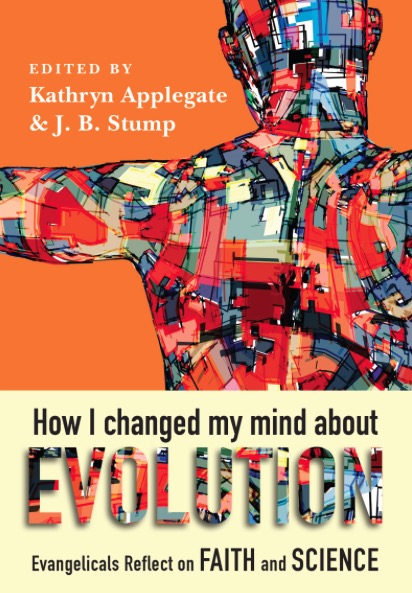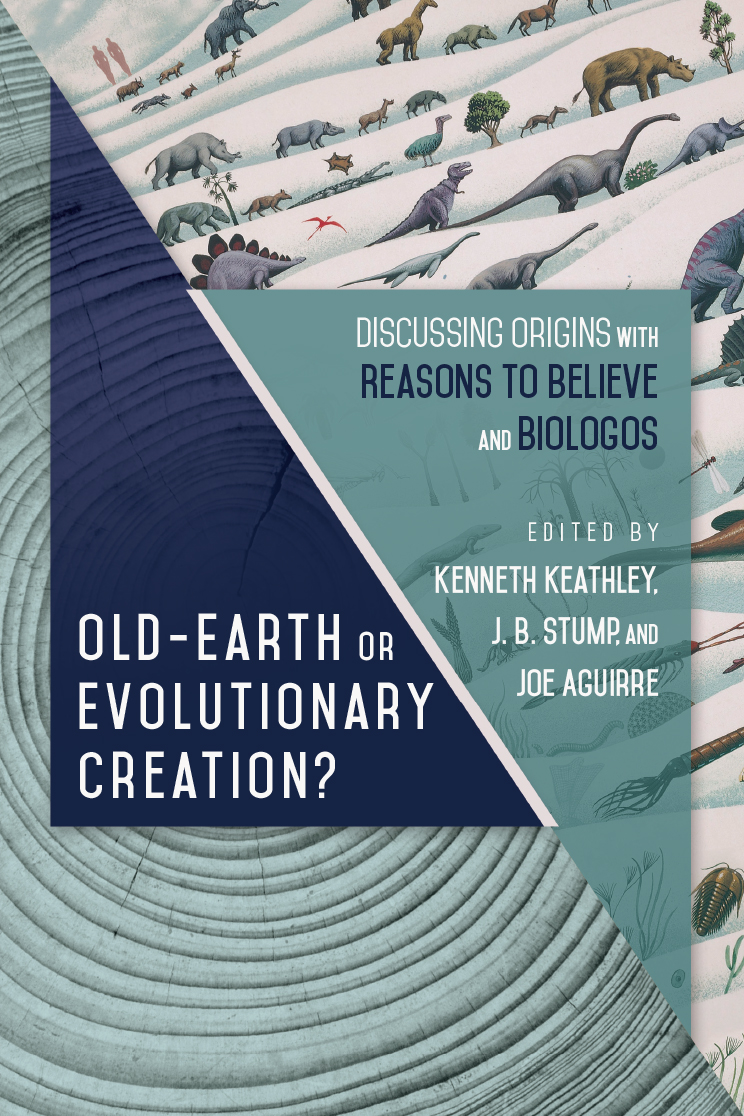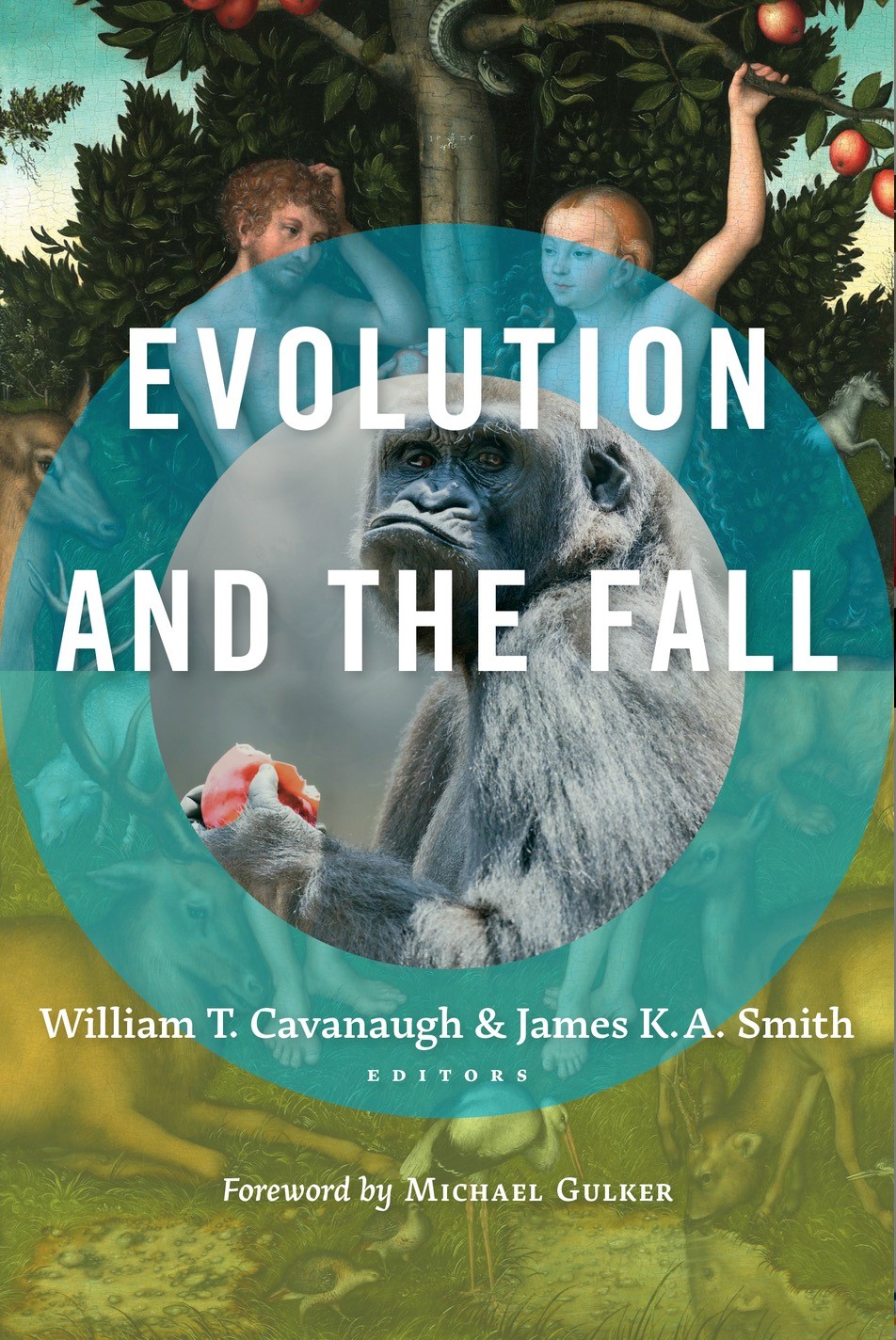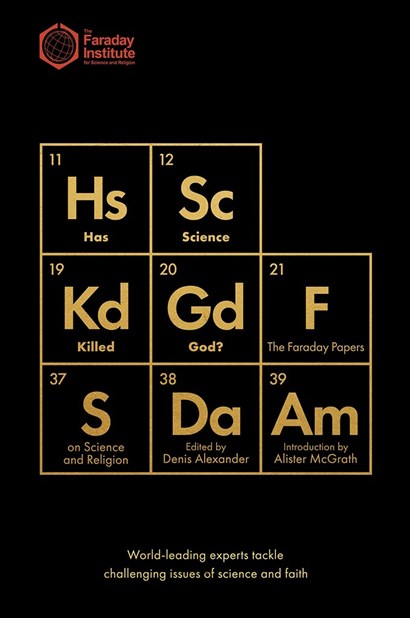

Adam, Anthropology and the Genesis Record: Taking Genesis Seriously in the Light of Contemporary Science.
Download PDF
Note: This article has lost some formatting when copied onto the website. We recommend downloading the PDF for a better copy of the article.
Allan John Day
Allan John Day is Emeritus Professor (Physiology) University of Melbourne, Australia, a Senior Academic Fellow, Ridley College, Melbourne and a Fellow of ISCAST (Institute for the Study of Christianity in an Age of Science and Technology).
Abstract
Much of the perceived conflict between science and Christian belief is not due to any intrinsic disagreement between these two approaches to truth, but rather to the conflict of emerging science with entrenched interpretations of Scripture. The history of the science/faith interface attests to this fact from the time of Galileo and before. It is important therefore, in interpreting Gen. 1-3, to take into account the findings of contemporary science. This approach should be made, not as an attempt to conform science to the bible or the bible to science, but rather as one in which science serves along with history, culture and language as one of many inputs into the interpretative exercise. The important message of Genesis and of the role of Scripture as the Word of God is not compromised by such an approach, but rather enhanced and its relevance in the contemporary scene emphasised.
In this paper an attempt is made to assess the findings of modern anthropology in relation to the interpretation of the Genesis account of Adam and the Fall. It is maintained, that neither a strictly literal interpretation, nor one which identifies an individual historic Adam with the Biblical Adam, is consistent with the findings of cultural and physical anthropology. On the other hand, it is proposed that an interpretation suggesting a generic (representative humanity).
Adam and a gradual emergence of both humanity made in the ‘image of God’ and of the Fall is consistent with a proper interpretation of Gen. 1-3. It is maintained that the essential message of Gen. 1-3 with its theology of humanity created in the image of God and embracing the development of a sinful human nature needing redemption is not compromised by this reading.
This paper was previously published in Science and Christian Belief 10, no. 2 (1998): 115-143. It is reproduced here with permission. An earlier version of this paper was presented as a basis for the Workshop on Biblical Interpretation and Science at the ISCAST Conference on Science and Christianity in Sydney, July 1997, and published as ZADOK Paper S90 in September 1997.
Key words
Adam, Fall, Anthropology, Genesis, Biblical Interpretation.
Introduction
The perception still persists, in both the Christian community and in the wider secular world, that scientific explanations of natural phenomena have rendered redundant the biblical account of origins. Such a perception is sharpened, not only by the spectacular nature of the developments in modern cosmology, but also by the findings of modern biology and molecular genetics. This is particularly evident, with regard to the dynamic nature of biological species and of the antiquity of humanity. These findings are widely publicised by the popular writings of scientific triumphalists (Atkins 1981, Dawkins 1988, 1989, 1995, Hawking 1988, Sagan 1980), many of whom mistakenly consider the findings of science and the Genesis accounts of origins to be in direct competition. Dawkins, for example, in his recent book, River out of Eden, comments:
Science shares with religion the claim that it answers deep questions about origins, the nature of life, and the cosmos. But there the resemblance ends. Scientific beliefs are supported by evidence, and they get results. Myths and faiths do not. (Dawkins 1989 p. 37)
‘Creation Science’ also considers conventional cosmology and biology to be in direct competition with the Genesis account of origins. Their particular interpretation of Genesis, presents a ‘young earth’ position, with the cosmos being formed by a series of special creation miracles in 6, literal 24 hour days some 10,000 years ago and with Gen. 2-3 being a literal and historic account of the special ‘formation’ of humanity and of the Fall (Whitcomb 1961, Morris 1993).
Unfortunately this interpretation of Genesis is interpreted by many in the secular world, as well as many in the church, as representing the only Christian position with regard to ‘Creation’, and as such is seen by most observers to be irrelevant in a modern scientific age. In this climate it is difficult to sustain any rational claim for biblical relevance in matters of origins.
If these issues are to be resolved and a proper biblical approach to creation taken seriously in the modern scientific world, it is necessary for Christians to address this problem and to address it primarily and urgently as a hermeneutic issue. This involves re-examining the interpretation of Scripture in relation to the findings of modern science and determining what the creation accounts are concerned about and how this is expressed in a world explained by science.
The issue is not a new one. It has exercised the energies of biblical expositors (both Jewish and Christian) for as long as Scripture has been studied (Jaki 1992, Sasse 1958 pp. 65-73, Young 1995). Nor are the basic issues new – they re-emerge with each paradigm shift of culture or science. The Church Fathers struggled with Platonist and Aristotelian concepts of science as they variously interpreted the Genesis creation accounts in either an allegorical or literal way (Sasse 1958 p. 68, Jaki 1992 pp. 70-108). In the 17th Century, the church wrestled with Copernican heliocentrism, and its implications for an understanding of the centrality of the earth as seen to be clearly expressed in Ps. 93:1 and other similar verses. The ‘natural common sense’ interpretation of such verses seemed so much in accord with the astronomy of Aristotle and Ptolemy and inconsistent with the new science (Hummell 1986, Poole 1995 pp. 99-113, Birkett 1996 pp. 1, 13-42). Scientists in the 18th Century struggled with the geological evidence of the age of the earth (Brooke 1991 pp. 226-274, Rudwick 1986 pp. 296-321) and the date of creation, calculated so neatly from biblical genealogies by Archbishop Ussher (Young 1990 pp. 26-81), while those in the mid 19th Century struggled with the problem of Darwin’s natural selection and its implications for the static special creation of Paley’s ‘Designer universe’ (Moore 1979, Livingstone 1987).
Some of these issues still reverberate, particularly those regarding the nature and origin of humanity. Over the last 50 years, and particularly over the last two decades considerable data has emerged from both cultural and physical anthropology and also from human molecular genetics that cast doubt on the emergence of humanity in either a physical or in a cultural or religious sense in the recent past. The elucidation of many aspects of the psychological and neurophysiological basis for mind and brain has also raised problems for a conventional understanding of the soul, expressed in terns of a dualist body/soul model, with the soul as a separate spiritual entity (Jeeves 1993 pp. 119- 135, Jeeves 1997 pp. 98-126).
It is necessary therefore to evaluate the way in which we interpret the Genesis 1-3 passages. These relate of course to theological humanity – made in the image of God, and stress the development of sin and the need for redemption. Some of the presuppositions about these aspects however may be influenced by an outdated anthropology and psychology and need to be reviewed in the light of modern developments in these areas. Where does the soul fit in for example? Is it still valid to consider a special act of God as necessary for the creation of a ‘soul’.? The latter is often equated as the entity which conveys our possibility of relationship with God and so is identified with the image of God possessed by humanity. Should we not rather recognise and dismiss these presuppositions and with them the semi-deistic understanding of God that they imply, and embrace a proper theistic naturalistic origin, not just for physical humanity, but for humanity made in the image of God and capable of relationship with God. Many evangelicals however find it difficult to abandon special creation and seek to reserve God’s right to ‘insert a soul’ as it were. These are some of the issues that need to be explored in this paper. It is no longer possible to ignore the progressively emerging scientific picture of man’s origin and nature, and of its implications both for theology and for biblical interpretation. It is not necessary however to concede defeat and abandon the Scriptural record as outdated in the light of the findings of modern science. We must seek rather to re-examine the relevant passages with a view to reinterpretation if that seems necessary.
We can learn much from the mistakes of the past, where entrenched interpretations of Scripture were seen to conflict with developing science. As we do so we need to enunciate an approach to science and Scripture which will provide some guidance in approaching new problems as they emerge. Such an approach will take both Scripture and science seriously. Both are ways of seeking truth, Scripture providing the truth about God and science the truth about Nature.
Relating Scripture to Science
There have been a variety of ways in which the interpretation of the biblical creation accounts have been related to science. Some interpreters promote the predominance of Scripture as the source of all knowledge, scientific and theological, espousing a principle of “scientific inerrancy”.
Some subjugate biblical interpretation to contemporary scientific theory, bending the text if necessary in seeking a scientific concordance.
Basically, the ways of relating Scripture to scientific findings may be considered under 4 main headings.
Biblicist or literalist
In this model, interpretation of aspects of Scripture referring to the natural world is based on Scriptural data alone, interpreted literally – Scripture is interpreted without reference to extrabiblical data and this interpretation is then imposed on our understanding of the natural world. The Bible thus becomes the arbiter, not just of theology but of science, the fount of all revelation, special and general. Morris, for example, affirms in relation to cosmology that:
Divine revelation is required if we are ever really to know anything about the creation – its date, its duration, its methods, its order or anything else about it. (Morris 1968 pp. 30-31)
There is an element in which this model emphasises the important principle of the primacy of Scriptural revelation in theological matters. It affirms that there are areas in which one cannot yield to apparent conflict with extrabiblical evidence. However, the understandable concern for this principle has often led to an espousal of interpretations that are basically concerned with scientific matters and are not theological at all. It is one thing to maintain that Gen. 1: clearly enunciates a theology of God as Creator – i.e. that ‘In the beginning God created the heavens and the earth’ – that all things owe their existence to Him – and quite another to maintain that a literal understanding of Gen 1, in terms of 6 days of 24 hours, is an essential theological truth. Unfortunately this approach often leads to an attitude which is prepared to ignore any scientific data which does not support a particular interpretation, on the pretext of defending biblical infallibility. As Kidner rightly points out, many who defend biblical infallibility in this way are simply defending the infallibility of a particular interpretation (Kidner 1967), a rather more doubtful cause to champion.
Espousal of a purely biblicist or strictly literalist approach to interpretation leads to inevitable conflict with modern scientific findings These have been dealt with in a variety of ways.
The first is to ignore the existence or relevance of the scientific data. This is to engage in intellectual dishonesty. To simply dismiss the evidence for the age of the earth, or the evidence concerned with the evolution of man, is being frankly dishonest in the face of scientific truth. Biblical principles are expressed in physical terms – creation in terms of the physical world and the image of God in terms of biological man. One cannot separate these interrelationships between God and nature nor ignore them in considering the interpretation of Scripture. Nor can we misuse the Bible to explore and determine physical truths about nature.
The second solution to perceived scientific discrepancy is to resort to miracle, where such an action is not indicated by the text. This approach denies a God active in natural processes, presupposing a semi-deist God, who intervenes only at intervals in his creation, in essence a sort of master magician. The cold hard fact however is that we cannot interpret Gen. 1-3 in a strictly literal way, unless we either abandon the scientific data or propose a series of miraculous events. The concept of God bringing about (and sustaining) his creation by natural means according to ordered processes described by science is thus sacrificed in the interests of a strictly literal and biblicist approach to Scripture and a semi-deist concept of God.
Such biblicist interpretations of Scripture in the light of quite contrary scientific information brings ridicule from the scientific community (Plimer 1994) and brings discredit on all biblical accounts of creation. As scientists and Christians we cannot ignore or distort the scientific data, but must look at it humbly as searchers after truth.
Concordist
In this model the Scriptural interpretation is constrained by the contemporary scientific view. It is seen as necessary to have Scripture confirming science, but in practice that must mean confirming the current scientific theory. Thus scriptural interpretation becomes subservient to the current scientific theory. It has a long history in the church (Jaki 1992, Young 1987 pp. 49, 257-304). Consideration of this history illustrates the folly of tying interpretation too closely to ‘contemporary science’ and indeed such a practice has led to many conflicts. It is one thing to accept the scientific data for an old earth and another to seek to conform the sequence of events described by science with the Genesis record. To seek to fit the days of Genesis, for example, into a cosmogenesis involving a day-age sequence representing millions of years.
Concordance fails to recognise the importance of biblical genre. It conforms and equates passages about nature to a historical, quasi- modern scientific framework. It fails to understand the nature of the literature and often as a result misses its important theological content in pursuing the somewhat different agenda of proving that the bible and science are in agreement. This concept is however still widely promoted by many. A recent proposal by Ross (Ross 1983, 1993) for example seeks to maintain ‘scientific inerrancy’ by a variation of concordism.
Such interpretations of the biblical accounts presuppose that the bible is concerned with presenting accurate science and that a defence of biblical infallibility must contain a defence of its scientific accuracy. This is of course a quite false premise. The bible speaks in everyday language and in the concepts and cosmology of the ancient world, not in terms of modern science. One can consider the concept of God the Creator of heaven and earth, without this being expressed in terms of modern science.
Separatist
This approach suggests that science has its own agenda and should be interpreted on its own terms, not constrained by scriptural input. On the other hand, it maintains that Scripture should be concerned with matters of faith and conduct and not seek to interpret matters concerned with the natural world. Such a separation is part and parcel of the development of modern science and the well known analogy of the two books – the book of the Word, Scripture and the book of the world, nature – originally suggested in the 2nd-3rd Century by Tertullian and developed by Francis Bacon in the 17th Century – underlines these principles. Thus while science and Scripture might be considered complementary in approaching truth, their epistemologies are distinct and in approaching biblical interpretation it is considered that science needs to be kept at arms length. Biblical passages concerning nature are then interpreted in theological not scientific terms. It is maintained that to allow primary scientific terms to intrude is often done at the danger of missing the theological point of the passage.
Having said that however, one must assert that to adopt a completely separatist approach has two dangers. The first is to allow scientific explanation to usurp authority in matters theological or metaphysical. To become the larger of the two books of truth as it were. It is easy to promote a scientific triumphalism, not just amongst scientific atheists but by those who would promote natural theology above biblical revelation as a way to God. It is a warning about the danger of science, rather than Scriptural revelation, interpreting God. The second danger is that scientific data might be excluded as legitimate extrabiblical data in the interpretation of the biblical accounts. The use of historical and language data are not questioned as legitimate inputs to hermeneutics. Surely scientific data also provides appropriate input into the exegetical exercise and should be considered appropriate in coming to an understanding of the meaning of a particular text that touches on aspects of nature.
Complementarity
In this model Scripture and science are seen to be in concert, with science aiding in, or clarifying the interpretation. In considering a complementary approach to biblical interpretation one is simply restating, for this particular issue, that science and Scripture both reveal truth and must therefore complement each other. It is also to recognise that neither scientific theory nor biblical interpretation are necessarily the truth, but are current approximations of truth, paths on the road to truth. It is therefore highly appropriate that we maintain an attitude of humility as we come to the text and be prepared to reassess it in the light of emerging extrabiblical or scientific evidence. Kidner (Kidner 1967 p.31) succinctly reminds us that the telescope of Galileo did more to interpret Ps.96:10 with regard to the movement of the earth than the pen of the theologian.
On the other hand, one must also have a similar understanding of the tentative nature of scientific theory, of its subjective elements and its changing and often speculative nature. This does not give us warrant to ignore it or fail to take it seriously, but simply to give it the appropriate weight as one of the factors to be considered in interpreting Scripture.
Taking the Bible seriously – as Scripture
As evangelicals we come to the Bible as Scripture in terms of 2 Tim.3:16: ‘All Scripture is given….’. Immediately this brings presuppositions to interpretations, but every interpretation comes with presuppositions, whether liberal, feminist or purely literary. The evangelical position in regard to biblical criticism is set out well by Armerding (Armerding 1983 p. 1-19), and needs no expansion in the present context. It asserts the authority of the Bible as God’s revelation to man. It is therefore not just information or literature. It can properly be studied as both, but as evangelicals we come to it as the ‘Word of God’ – revealed truth, to be interpreted by the Holy Spirit.
However, its revealed truth is conveyed by human vehicles – it is both a divine and human book. It is written in the language and context of the times and it expresses the truth about nature in terms of the cosmology of the Ancient Near East. The understanding of the Old Testament writers, as is apparent from a wide selection of text is of an essentially three-decker universe with a flat earth sitting on pillars and bounded by the sky as the canopy across which the sun travels. The firmament separates the waters above the earth and below the earth. So we have the separation of these watery components described in Gen. 1:1-14. We also have the sky stretched as a tent (Ps.104:2, Is.40:22), the earth immovable (Ps.93:1, Ps.96:10), and the sun moving across the heavens (Ps.19:4-6). Such examples could be multiplied repeatedly. The spherical world of the Greek philosophers caused some consternation for the Church Fathers.
Furthermore the Scripture is expressed in everyday language, not scientific language. It is not a source of modern scientific data, nor should it be interpreted as if it is expressing science or be defended on those terms. The Scripture does not contain all knowledge, but rather that which relates to God and his relationship to the world and to man, to matters of faith and conduct. Bernard Ramm’s restatement (Ramm 1955 pp. 45-54) of some of these issues bears underlining
Taking science seriously
Scientific investigation in matters concerning nature is meant to be a search for truth and, rightly interpreted and understood therefore, cannot conflict with Scriptural data also rightly interpreted. It should be rightly considered along with other extrabiblical information in order to clarify the meaning of the text (Lucas 1987 pp. 12, 46-51). This may involve reinterpretation of the text if that is demanded. Often interpretation in such matters is bound by scientific presuppositions in any case. For example, Ps.93:1 and the immovable earth was related to the astronomy of Ptolemy. The interpretation of Gen. 1 was tied to a static understanding of the world and the understanding of the age of the earth tied to the chronology of Ussher, based on supposed historical evidence from genealogies. The problem is to navigate between the twin rocks of a ‘Biblicist approach’ which evades the scientific data as being irrelevant and unimportant and a ‘Concordance approach’ which conforms the text to the current scientific theory and misunderstands the nature of biblical revelation as presenting scientific rather than theological knowledge.
Let us turn then to an application of some of these principles to the problem of Gen. 1-3. To ask whether we need to re-examine and reinterpret the biblical description of the nature and origin of theological humanity made in the image of God, in the light of the findings of physical anthropology and genetics about the nature and origin of biological humanity. Or to consider what is meant by original sin and the Fall. These are the issues of interpretation that face us in Gen. 1-3 in the light of modern anthropology and biology. Before considering these issues more fully however, in the context of Gen.2 and 3, it is necessary to examine briefly the broader issue of Gen. 1 and in particular the meaning and implications of being created in the ‘image of God’. This is the term used most commonly to characterise the nature of theological humanity as distinct from the sub human creation.
Gen. l:l-2:4a – Creation by the word of God
Made in the image of God
The first creation account outlines the basic theological dimensions of Creation. It examines dimensions of the Creator, the created world and of humanity created in the ‘image of God’. It is set in a framework of six days of activity, followed by a sabbath rest. Creation is effortless, by the Word of God. ‘God spake and it was done’. All things are portrayed as arising by the will of God. They are separate from God, contingent on His activity and declared ‘good’. There is no polytheism, no pantheism or no dualism. Light and Darkness, the heavens and earth, the waters below and above the earth arise at His command. The sun and moon (greater and lesser lights) and the stars are made to populate the heavens and the plants and animals to populate the sea and land. This creative “hymn” culminates on the sixth day, which occupies considerably more space in the account than any other day, with the creation of humanity, male and female in relationship with each other, with the rest of creation, and with God. The importance of the event, and of humanity as set apart from the animals, is emphasised by the use of the Hebrew verb bara‘ used only twice in the preceding verses (Gen. 1:1 and Gen. 1:21), but three times in Gen. 1:26-28 with respect to humanity. The emphasis is on the creation of humanity, male and female, made in the ‘image of God’. Bara‘ is used in the Old Testament with God as the subject of the verb, but it does not imply immediate, instantaneous creation as opposed to process (Kidner 1967 p.44). It need not be construed to imply a separate special creative act, nor to imply creation ex nihilo. Ps.51:10 ‘Create (bara‘) in me a clean heart’, and Is. 43:15 with respect to the creation of Israel, indicate God’s activity but not an ex nihilo activity. The discussion of the cluster of verbs (and there are several) in addition to bara‘ used to describe God’s creative activity is beyond the scope of this paper and other sources must be consulted (Wenham 1991 p. 14, Botterick 1975 pp. 242-249, Jenni 1997 pp. 253-256). From the standpoint of this paper it is important to recognise that God’s creative activity with respect to humanity, need not be envisaged as a special and separate creative act. The stress is on the artist’s freedom and power – a picture of God’s sovereignty in creation.
Humanity is described as being created in the ‘image of God’ (Gen. 1:26- 28). The specific meaning of the image of God given to humanity has been extensively discussed throughout history and a full consideration is beyond the scope of this paper and must be sought elsewhere (Wenham 1991 pp. 29-34, Berkouwer 1962). Some comments however are necessary. The term is used sparingly in Scripture. It appears again in Gen. 5:3, where Seth is born with a transmitted ‘image’ and again in Gen. 9:6 referring to humanity created in the ‘image of God’ and therefore having certain human rights in contrast to other animals. It is a term used also of Christ (Col. 4:15). He is the perfect image of God to which we in redemption will be conformed.
It has variously been considered to relate both to the rational and moral characteristics of humanity, but two aspects are considered paramount, those of relationship and dominion (Barth 1960 pp. 203-285). As God is relational, so humanity is relational, both in a horizontal sense with regard to other humans, but in particular to God. Humanity is created capable of fellowship with God and capable of acting as God’s steward. These are the particular characteristics of humanity (given by God) that places humanity in a special place in creation. This does not imply however that humanity has a distinct and separate origin in the evolutionary process, nor that these relational characteristics may not be observed by rational and scientific study. The latter may therefore have some comment on the nature and origin of the ‘image’ and of an interpretation of aspects of revelation that relate to it. One also cannot imply from the text that the ‘image of God’ is concerned with a part of humanity divorced from the body, or that it can be equated with a separate ‘soul’ or spiritual entity. Although this view has been widely held, it has repeatedly been rejected by exegetes and theologians. Berkouwer in his monograph emphasises this point
Scripture’s emphasis on the whole man as the image of God has triumphed time and time again over all objections and opposing principles. Scripture never makes a distinction between man’s spiritual and bodily attributes in order to limit the image of God to the spiritual, as furnishing the only possible analogy between man and God. (Berkouwer 1962 p. 77)
He further comments:
It is obviously not the intention of the divine revelation to give us exact information about man in himself and thus anticipate what later scientific research on man offers. (Berkouwer 1962 p. 199)
Thus man in his totality in relation to God is part of the image. The manifestations of man made in the image of God as a spiritual being capable of relationship to God may thus be observed scientifically both by the investigation of contemporary religious experience and in the cultural anthropological record.
Context – Background and World View?
The Ancient Near Eastern creation myths give a background and context for the Genesis story (Wenham 1991 p. xlvi-l, Hess 1995). They express the world views of the nations with which early Israel was associated. The similarities, therefore of Enuma elish and other creation myths to the Genesis account can be seen as a background to the polemic against polytheism which is the message of Gen. 1 (Heidel 1951, Jacobsen 1976 pp. 167-191, Hasel 1974 pp. 46, 81-102). Gen. 1 declares the world view of Israel as compared to that of Babylon. God is separate from and master of creation, not part of creation and struggling for mastery. Humanity is created not to save the gods from drudgery but for the higher purpose of fellowship with God. Thus the message is not one of origins, but of theology. It is not a scientific document, but a theological one. It is doubtful if the question of origins was of concern to the writer of Genesis or to his hearers. The question of the nature of their God however was the important issue. Yahweh creates effortlessly by his Word, brings order out of chaos, in contrast to the polytheistic struggle of Marduk for supremacy in the Babylonian pantheon of gods. This context must be clearly in mind as we seek to interpret what the text says to the hearers to whom it is addressed.
Thus Gen. 1 is concerned with the Biblical doctrine of creation, not of providing a description of the scientific details of origins. God is declared as separate from creation. There is no polytheism, no monism, no dualism. Creation is declared as good. Humanity is declared as special, created in the image of God, relational, having dominion over creation as God’s steward. The sabbath is created as an ordering principle of creation, as God rested so humanity rests (Sherlock 1984).
It is thus a polemic against the contemporary Ancient Near Eastern world views. It forms the fundamental background to humanity and their relationship to God. As such it is not in any way in conflict to modern science, but brings important principles that themselves form a context for science, giving nature purpose, and humanity a responsibility to God as Creator. It is concerned with who God is and who we are, not the how of creation.
Genre – Literal or Literary?
The findings of cosmology, geology and biology suggest that the days of Gen. 1: cannot be considered as literal 24 hour days. Evolution, both of the physical universe over 15 billion years and of biological species including humanity, is not consistent with a recent creation of the universe or of a special creation of individual kinds of animals. The attempt to circumvent this problem by postulating some gap between Gen. 1:1 and Gen. 1:2, or by some day-age theory as proposed by concordists not only fails to produce any clear correspondence with the text, but fails to take note of the internal evidence of Scripture. The use of numbers, of structure, of repetition and of sequence all strongly suggest a literary construction, built up in what is after all an ancient Hebrew document, where all of these aspects are important for meaning. These issues are taken up fully by commentators (Atkinson 1990 pp. 13-51, Wenham 1991 pp. 5-10, Blocher 1984 pp. 15-38, Westermann 1987 pp. 6-13) and are beyond the scope of this paper.
It seems most satisfactory to consider the 7 day structure of Genesis 1 to be a literary device – an effective means of bringing out the primary theological truths of Genesis 1, of conveying the Hebrew understanding of God and nature (Blocher 1984 pp. 49-59, Thompson 1968 pp. 12-23).
These truths of a God separate from nature (and responsible for it by effortless creation) were revolutionary in the context of the polytheistic Ancient Near East, where gods and nature overlapped. The nature of this creation is properly the province of science to explore, not for Genesis to describe in any case. God’s ability to create in any way He wills is not disputed by any of the interpreters, and the fact of God’s involvement is not of course, the province of science. Any conflict of Genesis 1 and science therefore evaporates with the above scenario.
There is however a residual unwillingness to surrender the origin of humanity created in the image of God (Gen. 1:26-28), to the scientists. Many evangelicals still maintain some form of special creation for humanity, the insertion of the “soul” by a special act in pre Adamite humanity (Pearce 1970 p. 130, Berry 1988 pp. 65-70). There is a certain amount of inconsistency in this view. The clear distinction of humanity from sub human species (as is their commonality with lower animals as an integral part of creation) is a clear theological and Biblical truth and is not disputed by science (Leakey 1994 pp. 117-157). The literary form of
Gen. 1 reinforces this distinction by the amount of space given to the 6th day and the creation of humanity, male and female capable of relationship with God. To preclude any particular scientific means of origin however, particularly in the face of the scientific data, is to hang onto a particular interpretation rather than to hang onto a theological truth. The issue is more acute in the interpretation of Gen. 2 and 3 with its clear anthropomorphic focus and narrative style and will be taken up again below. Before considering Gen. 2 and 3, however let us then look briefly at the scientific data re humanity’s origin and its implications.
Human pre-history and human evolution
Space precludes more than a brief account of the origin and nature of humanity as understood by current anthropology. For more detailed information both popular (Leakey 1994, Burenhuit 1993, Fullick 1997) and more academic accounts (Jurmain 1994, Jones 1992, Stringer 1996, Foley 1995, Johanson 1996) can be consulted. It can be asserted however, on the basis of the scientific data, that modern humans (Homo sapiens) date from at least 100,000 years ago and may be as old as 200 thousand years or even more. Examples of species representing intermediate forms between what are believed to be common ancestors of apes and modern humans have been identified at earlier periods. The evidence for this picture of human prehistory and for human evolution comes from three main sources, which although presenting some dilemmas essentially reinforce each other.
The first is from paleoanthropology – the study of fossil humans. The second is from molecular biology. This includes both genetic data for microevolution and also for the commonality of ancestors. The third comes from social anthropological studies regarding tools, art and language associated with the prehistory of humans. Such cultural considerations are of considerable importance in assessing the prehistory of humanity as a social and religious being. These need to be considered briefly in turn.
Fossil evidence, skeletal and cultural
There are now increasing numbers of fossil remnants, that have been found over recent and not so recent years, which represent a number of distinct pre-human (Australopithecus) and human (Homo habilis, Homo erectus, Homo sapiens) species. These provide a transition series, although admittedly a sketchy one representing species intermediate between supposed precursors of modern apes and modern humans (Homo sapiens). The transition from quadripedalism to bipedalism, together with the increase in skull (brain) size, both features that characterise modern Homo sapiens, can be discerned from the fossil data. While many of these fossils are relatively small fragments, on which much superstructure is built, there are also virtually complete skeletons e.g. Turkana boy (Leakey
1992 pp.41-64, Brown 1985). There is no suggestion by anthropology however that modern apes are precursors of modern humans – apes developing into humans – but rather the conclusion of a shared ancestor perhaps some 6 Million years ago (mya)or more.
Prehuman fossils (Australopithecines – the so called Ape Men) have been discovered in S and E. Africa in layers dated around 5 mya. They are characterised by bipedalism, but have a protruding jaw and a smaller cranial cavity compared to that of the big brained Homo sapiens. There is a similarity to apes but they have shorter canine teeth. They are not considered to be a direct ancestor of humans, but to come from common stock. There are several views however about the relationship of Australopithecines to human (Homo)species and of the particular connections in the line of descent. Further information about this aspect needs to be sought elsewhere however (Jones 1992 pp. 231-240, Strait 1997, Skelton 1998).
Fossils representing early Humans (Homo habilis, Homo erectus), and characterised by both definitive bipedalism and a further enlargement of the cranial cavity (2/3 of modern humans), appear in Africa at 2-3 mya. Finds in Asia show subsequent successful global spread of Homo erectus to this region at somewhere between 1 million and 500,000 years ago. This global spread is represented in Indonesia by Java Man (and by other fossils dating from 1 million to 100,000 years ago) and in China by Peking Man (and other fossils dating from 2.3 million to 800,000 years ago) and in Europe by Heidelberg Man and other specimens (300,000 years ago).
These classical finds have been supplemented by a variety of more recent material (Jones 1992 pp. 241-251). A new hominid species, named Homo antecessor, and dating from 780,000 years or older, has recently been described in Spain and evidence supporting its identity as a possible ancestor to Neanderthals and modern humans presented (Bermudez de Castro 1997, Gibbons 1997, Lewin 1997). Neanderthals might be considered a special case. They probably originated from European ancestors and are not now considered to represent the ancestors of modern Homo sapiens. This conclusion has recently been strengthened by the remarkable achievement of the sequencing of DNA from Neanderthal fossil bone fragments (Krings 1997, Lindahl 1997, Ward 1997). The conclusion from these studies is that there was a period of some 500,000 years during which Neanderthals and the line leading to modern humans evolved independently.
The early fossil sites often show an abundance of the first ‘made’ tools, Oldowan tools at 2 mya. More advanced Acheulean tools (hand axes) appear at 1.5 mya and evidence for the use of fire at 700,000 years ago. We thus have abundant evidence for distinct species of ancient (?pre Adamite) humans with some features of rational development from as long ago as 2 mya. Recently finds of tools as old as 2.5 mya have been described (Semaw 1997, Wood 1997) raising the question of an even longer history of these early Homo species.
There are many unanswered questions of detail and also matters of dispute. Recently a specimen of Homo erectus has been described in Java, but dating from only 27,000-53,000 years ago (Swisher 1997, Gibbons 1996). This is some 250,000 years later than Homo erectus on the Asian mainland. There is therefore a considerable period of overlap between Homo erectus and Homo sapiens. The earliest specimens of hominids date from 2.3 mya and as indicated above early hominids have been found in Europe at Atapuerca in Spain at 780,000 years ago (Gutin 1995, Bermudex de Castro 1997). The discovery of hunting spears in lower Paloelithic sites in Germany at around 400,000 years also raises the issue of advanced skills being present in Europe at this early period (Theime 1997).
Fossil data of humans identical to modern humans (Homo sapiens) appear first in E. Africa at about 200 thousand years and show evidence of successful global spread to West Asia (100,000 years ago), Australia (50,000), Europe (40,000), and N.America (15,000). They are characterised by a further increase in brain size compared to Homo erectus and the development of more sophisticated tools, of art and of religion (15,000-30,000 years ago). It will be noted that this places Homo sapiens, with apparent evidence not only of rationality but of religious characteristics well before the apparent Neolithic setting (see Pearce 1970 pp. 47-63) of the Adam of Genesis 2-4.
The widespread migration of early hominids suggested earlier that development of Homo sapiens took place at a number of sites from the existing Homo erectus ancestors (Wolpoff 1989 pp. 62-108). This possibility has now been largely discounted. The most satisfactory explanation is given by what is termed the ‘single origin hypothesis’, in which it is postulated that Homo sapiens has a single East African origin from an African Homo erectus ancestor some 150,000-200,000 years ago, with subsequent global spread (Stringer 1989 pp. 67-96). This is supported by the molecular genetic data discussed below. This is the so called Noah’s Ark theory. It must be made clear however that the common origin is envisaged at something like 200,000 years ago and in E. Africa, not at the time of Noah’s flood, either local or universal (some 5,000 years ago), centred in West Asia.
There are, however other possibilities, notably the ‘multiple origin hypothesis’ proposed and aggressively supported by Wolpoff (Thorne 1992). This hypothesis, which has had stronger support in the past, envisages that different racial groups of Homo sapiens have a multiple origin, arising separately in different geographic areas from Homo erectus, known from the global spread data to precede Homo sapiens in many areas. Wolpoff’s conclusion however is not shared by many physical anthropologists and most emphasis is currently given to a common origin of modern humans in Africa and a spread to other areas, descendants of early humans (H. erectus) having become extinct (Leakey 1994 pp. 79- 99). A further alternative has also been suggested, with a series of migrations of early Homo sapiens from Africa followed by the genetic mixing with archaic populations previously established in Asia Further discussion of this area and of the proposed but rejected role of Neanderthal man as a possible progenitor of Homo sapiens is beyond the scope of this paper. For a more detailed treatment, other more extensive works must be consulted (Stringer 1989 pp. 67-96). This issue has theological implications in regard to the common ancestry of humanity and their uniqueness, made in the image of God.
Genetic data
This consists of both evidence for microevolution in human populations and of genetic data demonstrating that the DNA variation of current races of Homo sapiens can be traced to common antecedents. Thus modern genetic research has been able to tell us how long the various human races have been separated from each other and how they are mutually related.
A good example of evolutionary pressures in human populations today can be illustrated by subjects suffering from Sickle Cell Anemia. These individuals have an inherited difference of one amino acid in the B Haemoglobin chain. This trait shows positive evolutionary selection in malarial areas, where sickle cell anemia conveys resistance to malaria, but shows negative selection in normal populations where the anemia trait has negative survival value.
DNA sequencing of living species can be used as a ‘molecular clock’ to calculate evolutionary distance between species and to provide divergence data for a variety of lineages. Modern humans share more than 98% of their DNA with higher apes – gorillas and chimpanzees, indicating a close relationship with these species of primates. On this basis there is a closer relationship between humans and chimpanzees than e.g. between horses and zebras which are capable of mating and producing offspring.
Genetically derived DNA is present in the mitochondria of all cells, as well as in the nucleus. Since this mtDNA is derived from the female line only (mtDNA comes from the ovum cytoplasm, the sperm contributing only nuclear DNA2), it provides a means of comparing and studying transmission of characteristics through one parent line, uncomplicated by the admixture which would complicate similar studies using nuclear DNA which of course comes from both parents. It presents therefore a unique way of following a lineage in relation to time. Comparison of mtDNA of present day populations indicate maximum variation in African populations, with African variants always present in other geographic populations, but not vice versa, By calculating rates of mutation in a diversity of populations it has been possible to demonstrate a common origin in Africa some 150,000-200,000 years ago, for widely diverse current populations of Homo sapiens, at least with respect to the female line. It can be calculated that the female line of all other descendants of all other mothers became extinct over 50,000 generations, leaving only one set of matrilineal descendants. While his data by its very nature relates to a common female antecedent, it can be asserted that the (this is not strictly true. See Ankel Simons 1996) chance of ‘mitochondrial Eve’ mating with the common male antecedent is so small that it is virtually non existent. Thus it is reasonable to assume that the common female parent can also be considered as part of a common antecedent pair from which modern Homo sapiens developed.
These observations, derived from the classical studies of Wilson, Stoneking and Cann and others (Cann 1987, Wilson 1992) form the basis of the variously termed ‘African Eve’, ‘Mitochondrial Eve’ or ‘Garden of Eden’ hypothesis3, but there have been a large number of confirmatory studies (Horai 1995). These show a reasonable correlation of the date of the common ancestral DNA. They include studies on mtDNA and also of studies using the Y chromosome (Hammer 1995). Dates from 156000 years (Goldstein 1995) to 270,000 years Dorit 1995, Paabo 1995) are estimated so that a common ancestor at around 200,000years appears likely. These studies place our common male and female ancestor in the late Middle Pleistocene, only slightly before the hypothesised origin of modern humans based on the fossil data. Such studies deal a body blow to the multiple origin hypothesis.
Cultural data
This evidence is perhaps the most critical in considering the relationship of early humans to the biblical concept of theological humanity, created in the ‘image of God’ and having the capacity to relate to God and to serve as his representative.
Conceptual reasoning needed to make formed tools appears relatively early (Gutin 1995). The development of language, the ability to communicate by abstract symbols, represents a major step in the cultural history of humanity, but is a rather later development (Mellars 1989 pp. 317-525). This together with early art images, such as ‘Venus’ figurines (Stringer 1996 pp. 112-142) and European cave paintings (Stringer 1996 pp. 112-142, Jones 1992 pp. 361-364) are part of a cluster of changes that appear at between 35,000 and 30,000 years ago (Burenhuit 1993 pp. 96-124). These are considered to represent primitive worship, evidence of the consciousness of spiritual reality. The presence of regular burial rituals from 30,000-15,000 years (Burenhuit 1993 pp. 138-138) is also part of this cluster of characteristics appearing at around 30,000 years and later that mark humanity as a social and religious animal, able to communicate by symbol and engage in religious activities that demonstrate an awareness of the spiritual dimension. Detailed consideration of these areas however, is beyond the scope of this paper. There is a large literature and there are many unresolved issues (Leakey 1992 pp. 237ff). What can be asserted however, is that there is convincing evidence for religious humans from at least 15 to 30,000 years ago.
The obvious question arises as to the significance of these data for theological humanity made in the image of God. One must ask therefore: ‘What does it mean then to be human?’, ‘Is there a continuum from the (3.For more detailed discussion of this hypothesis Dawkins 1995 pp. 35-66, Leakey 1992 pp. 218-221.) ancestors of apes to theological humanity made in the image of God?’, and ‘What is the scientific corollary of the image of God and where does sin fit in to the picture of evolving humanity?’.
With these questions in mind, therefore, let us turn to Gen.2-3 and consider the interpretation of the text in the light of the modern scientific concepts briefly reviewed above.
Gen 2-3 – Adam in Eden and the Fall
Perhaps the major issues, in any consideration of the significance of the anthropological findings for the interpretation of Gen. 2 and 3, are those raised by the historicity of Adam, his relationship to humanity as a whole and of the place of the Fall. Adam (humanity) is portrayed in Gen.2 as a farmer, in relationship with God, tending the garden of God. The context in which this relationship is set is certainly that of the Neolithic period (some 10,000 years ago). The nature and consequences of the fracture of this relationship is also set in the context of Eden with humanity being expelled from God’s presence. Adam is considered to be in solidarity with all humanity in their alienation from God because of sin. It is also set in the context of a variety of highly symbolic actions. God creates Adam from the dust and separates and rejoins male and female humanity.
Obedience and dependence on God are conveyed by the forbidden access to the tree of the knowledge of good and evil and by the entry of sin from within the created world. Gen. 2-3 is not primarily concerned with a literal description of the method of creation of humanity, male and female, nor of the details of the origin of evil.
Gen.2-3 is thus primarily a theological statement, concerned with the relationship of humanity to God and the break of that relationship by sin, necessitating redemption in Christ. This key theological truth is foundational. It is not weakened in any way by interpretations of Gen.2-3, which are symbolic, nor does a non literal interpretation necessitate abandonment of the basic truths as some claim. The clear indication for such alternative interpretations becomes particularly acute as we see the conflict between anthropological data and an understanding of a historic Adam envisaged as a common ancestor of humanity located in a Neolithic context. As indicated above common antecedents are dated at around 200,000 years ago and evidence for religious humanity exists at around 15,000-30,000 years ago, not in the later Neolithic period (10,000 years ago). There are however a number of possible approaches that need to be considered, some of which are consistent with a historic Adam, but not the progenitor of all, and others which suggest a generic Adam with a gradual rather than instantaneous emergence of the image and of the capacity for sin. In all of these approaches we need to treat the Scripture seriously, but also to treat the relevant scientific findings seriously in terms of the principles outlined earlier.
Gen. 2-3 – Literary or literal?
In asking this question we are asking whether the text should be treated as completely literal, with Adam formed from dust and Eve from Adam’s
rib, God walking in the garden and a serpent speaking? It certainly doesn’t sit well with modern science and would not be interpreted in this way by any but the strict biblical literalists. Creation becomes a matter of miracle and science is irrelevant. However, even considering the internal textual evidence alone makes a strict literal approach unlikely. The text differs in form from the Gen. 1:1-2:4a account. In Gen.2-3 we have a narrative, a truth revealing story. The text is full of evident symbolism, so that many of the motifs used are best seen in this regard. – the serpent, the tree of life appear in other Ancient Near East literature (Kovacs 1989), Adam from dust, Adam’s rib – out of Adam to be reconstituted a whole in marriage, the strong anthropomorphisms with regard to God, are all features that suggest a literary style, rather than a literal understanding. Narrative criticism, as outlined by Wenham Wenham 1991 pp. 50-55) and others, also demonstrates a variety of literary constructions designed to bring out the message in Gen.2-3.
Genre – History, Saga or Myth?
Allegory, so common as an interpretive approach in the early eastern church, can perhaps be dismissed in present interpretive approaches. However a consideration of the means used to present theological truth about prehistory in Ancient Near Eastern cultures is relevant as we consider the nature of this ancient Hebrew document. The story form was the well recognised means of presenting truth in the literature contemporary with Genesis in the Ancient Near East and there are many examples of such documents that have been found over recent years.
Truths were brought out by telling a story and certainly the key truths of who we are and how we came to be like we are, is presented in a masterly way in the stories of Gen.2-3. This does not mean that the material is not dealing with history, but rather that the nature of the material necessitates a different approach. Normal history is dependent on oral or written records – of eye witness accounts. Here we are dealing with the proton – the beginning – and the nature of the proton precludes such records. Thompson Thompson 1968) outlines some of these problems well for the Gen. 1-3 text.
While it is agreed by Old Testament scholars that there are particular difficulties in such literature, a suitable term to adequately describe this genre is not agreed. To speak of such writing as myth needs qualification. Unfortunately myth is used with a variety of meanings and is often used as a pejorative term – popularly considered to be a story with no basis in fact, a fiction. Caird (Caird 1997 pp. 222-242) in discussing the use of this term, gives seven distinct meanings. It is necessary therefore, to define clearly which meaning one is giving to the Genesis writings. Drane defines myth in this context as:
a story which expresses a truth about human life that cannot adequately be described in terms of science or history. In this sense myth is as valid and respectable a way of thinking about life’s deepest meaning as science, art or philosophy. This is the type of ‘myth’ scholars have in mind when they use this term of the genesis stories. (Drane 1987 p. 244)
In this sense myth becomes a vehicle of truth about beginnings and a useful description of the events of Gen.2-3. Von Rad suggests the term saga for this type of literature. He explains his term as follows:
by no means is saga merely the product of free-ranging fantasy; it, too, conjures up history. It is the form favoured by a people for depicting its early history. Of course it does not feel bound by the modern demand for exactness. The saga comes from a quite different period of the people. Its roots are in a form of society preceding that of the state, which means that it lives and grows at a time when the power of rational and logical, historical perception is not yet fully liberated, at a time, however, when the powers of instinctive, intuitively interpretative, one could almost say mantic, understanding dominate all the more freely. In its sagas a people is concerned with itself and the realities in which it finds itself. (Von Rad 1972 pp. 32-33)
Wenham refers to the form as protohistory. He comments regarding Gen. 2-3:
Genesis puts these truths (about sin and its origin) in vivid and memorable forms in an absorbing yet highly symbolic story. (Wenham 1991 pp. 54-55)
It can be asserted therefore that a careful consideration of the text does not demand a literal approach. The perspective and message are paramount not the form. It can be variously describes as narrative theology, myth suitably defined or as saga or as protohistory. The terms are perhaps not important, they simply emphasise the difference of this writing from normal formative history and their role in conveying primarily theolgical truths.
Is Adam a historic person?
In asking this question we are not asking whether a single progenitor for humanity exists but rather whether the biblical Adam can be considered to refer to an individual rather than being used as a generic term for humanity. As Wenham (Wenham 1991 p. 32) observes, the fluidity between the definite and indefinite Hebrew construction of Adam (humanity or personal Adam) makes it difficult to know when the personal name is first mentioned. ‘The Adam’, with the definite article or the preposition ‘to (the) Adam’ meaning humanity, is the form used in Gen.1-4. Certainly the language and context of Gen. 1:26-28 is that of humanity as a whole. The translation of this Hebrew term, as Adam the individual, however varies in different translations, not so much because of the grammar but of the perceived context. The AV uses Adam early (Gen. 2:19), but the NIV and RSV translate it as Adam first in Gen. 3:17. The NRSV however does not use the proper name until Gen. 4:25 in conformity with the grammatical data.
The other internal textual basis for considering Adam as used in Gen. 1-4 to be a representative generic term comes from the use of the toledoth formula as a textual structuring device. The structuring of Genesis by the toledoth formula (‘these are the generations of…’) strongly suggests a historical picture with the series of genealogies and their narrative historic sequences continuing throughout the whole of the book (Wenham 1991 p. xxii). However it will be noted that the toledoth of Adam commences with the second toledoth at Gen.5:1. The first toledoth (Gen. 2:4b-4:26) is the toledoth not of Adam but of ‘the heavens and the earth’. It appears therefore that this segment has been constructed to fit the toledoth structure of the rest of the book. It represents therefore, a literary form rather than a genealogical table, as those from Gen. 5:1 onwards appear to be. The question therefore of a historic individual Adam remains open and alternative readings are consistent with the textual evidence.
In discussing this issue we need to consider three possibilities in turn. The first is the most conservative reading with Adam being considered as an individual farmer living in a Neolithic context in the Middle East at around 8,000-10,000 BC and being the progenitor of all humanity.
1. Adam in Eden as a Neolithic farmer (8,000-l0,000 BC) and the progenitor of all races
In an attempt to conform Gen.2-4 to the anthropological data, Pearce (Pearce 1970 pp. 47ff.) has presented a convincing case for Adam – the man – as a Neolithic farmer resident in Eden. This possibility is consistent with the known development of the first Neolithic culture in the Middle East at around 8,000-10,000 BC and conforms with the cultural details of the biblical text. This possibility has been attractive to a number of evangelicals (Kidner 1967 p. 28, Stott 1994 pp. 163-164). It follows from this reading that Biblical Adam in Eden can be considered to be a historic person and the progenitor of all racial groups. Further it can be concluded that Biblical Adam is of recent origin – part of a Neolithic culture arising approximately 10,000 years ago. Divine intervention in the evolutionary process is thus envisaged in order to create biblical Adam in the ‘image of God’ from pre Adamite humanity. This scenario takes into account biological evolution and the long history of (pre Adamite) humanity. It also allows for a historic Fall and its impartation to all humanity.
However there are significant problems in relation to the scientific data which must be addressed. Fossil Homo sapiens are identical with modern humans both in a physical and genetic anthropological sense, but appear at 150,000-200,000 years. The genetic data, as indicated above (‘Mitochondrial Eve’ etc.), supports a common origin of current races, but excludes such an origin before 150,000-200,000 years and puts such an origin in Africa not West Asia. The emergence of language, religion, art, etc., suggests a continuous process for the evolution of humans, including perhaps the development of the ‘image of God’. This position thus fails to explain the position of pre-Adamic humanity with their advanced culture and religious consciousness.
The next possibility also retains Adam as an individual historic person, but abandons the claim that Adam is the genetic progenitor of all humanity, envisaging rather a solidarity with humanity by imputation.
2. Adam in Eden as a Neolithic farmer, but not the progenitor of all racial groups.
Adam is therefore just a particular man from a larger group. Divine intervention in the evolutionary process of Homo sapiens must then occur to create the ‘image of God’ and Adam thus becomes the original ‘theological human’ – made in the image of God. This picture is also consistent with the proposal of Pearce, although the necessity of the conveyance of the image of God to parallel lines becomes an issue and difficult to fit with the text. With this scenario, the historic Fall cannot be imparted to those who are not descendants. Imputation of sin to all, including to parallel lines from an earlier common ancestor, can be envisaged. Adam then becomes the representative of humanity, by which sin is passed by imputation to all humanity in terms of Rom. 5:12 ‘just as sin entered the world by one man…’. This picture is consistent with the anthropological data – fossil and genetic. However there are some interpretative problems to be faced.
Gen.3: 20, appears to indicate a common ancestry through Eve ‘the mother of all living’. It can be argued however that the language and context suggests that Eve is rather the ‘mother of life’, a statement of faith in the future, rather than of anthropological origins (Wenham 1991
p. 84, Spanner 1987 p. 77). The creation of the ‘image’ in a Neolithic Adam and its relation or transmission to other clearly human groupings also becomes an issue difficult to fit with the text.
The nature of the Fall must also be considered in terms of the New Testament theological teaching of Rom.5:12-21, 1 Cor.15:21-23, 45-50. However as indicated above imputation, rather than impartation is consistent with the exegesis of these passages and with the general nature of sin and salvation. Biblical Adam is then considered as representative humanity – Federal humanity, rather than the physical ancestor of all. Both the unity of present humanity and the universality of sin are preserved (Kidner 1967 p. 30). Further interpretive issues arise with respect to pre-Adamite humans. Are they to be considered human? Is the Fall retroactive? These are difficult issues but must be addressed.
The third reading envisages a common ancestor as envisaged by the genetic data with a gradual development of the ‘image’ and a gradual, although non the less historic Fall. This reading is rather more controversial. Bloom, for example, in a recent paper (Bloom 1997) discusses the anthropological data, but concludes that modern discoveries do not offer compelling evidence to abandon the biblical account of a special creation of mankind in favour of a gradualist evolutionary scenario. He recognises the scientific issues but dismisses them in favour of a ‘biblicist interpretation’ resorting to special creation on the basis of the biblical record. However the possibility of a gradual process must be considered in relation to the scientific input outlined above.
3. Paleolithic Adam – progenitor as envisaged by the genetic data
This scenario envisages a single human origin coincident with fossil Homo sapiens, 100,000-200,000 years ago. There is then a progressive gradual evolution, the gradual emergence of the image and perhaps more controversially of the presence of sin. Both are historical, but not instantaneous. Biblical Adam is then identified directly with fossil humanity and the image and the emergence of sin are gradual. Gen. 2-3 becomes metaphorical, both paradigmatic and protohistorical, indicating in story form the reason why humanity are as they are – possessing the image of God but having a basic root of sin and in need of redemption (Wenham 1991 p. 91). This proposition needs to be developed further
Is the creation of the Image – and the Fall – gradual or instantaneous?
There seems to be no real theological reason to preclude human evolution as the basis for the origin of the special properties of ‘theological humanity’. No reason to exclude the development of ‘spiritual humanity’
– Adam made in the image of God – by an evolutionary process. The same theological arguments that justify the evolution of animals also justify the evolution of ‘spiritual humanity’. Creation by whatever means is the activity of God. We do not need to postulate special instantaneous creation for the creation of the Image any more than for any other aspect of creation. Many evangelicals however balk at this step, wanting to reserve the creation of humanity to some form of special creation. This was an issue that was worked through theologically by many of the prominent conservatives of the late 19th Century in relation to the challenge and implications of Darwinism, biological and social. Moore in his magisterial historical work on the Protestant responses to Darwinism establishes not only that Christian Darwinism was espoused strongly by conservatives in the church, but that it was seen by Calvinists as a clear example of the sovereignty of God in all aspects of nature (Moore 1979 pp. 252-298). Many in fact saw it not as a foe but as a friend in the context of rejecting deism and semi-deism – an intervening God. Many supported strongly the contention of God’s activity at every stage of creation and sustenance (Moore 1979 p. 268). Many saw no problem, rather a need, for God’s activity at every stage of evolution including the evolution of the image. Moore records of Asa Gray
He extended evolution to mankind, body and soul, and found warrant for this doctrine held for centuries by believers in original sin. (Moore 1979 p. 280)
and of James Iverach, the Scottish theologian, in response to the perceived deism of Wallace’s approach to evolution:
…but deism is a superannuated form of thought which cannot be resuscitated at the present hour.’ ‘Are we to hold that only at three stages can we find anything that points to a world of spirit?’ he demanded ‘Are we to bring in the world of spirit only where our
favorite theory fails? If there are breaks like these in the theory of evolution, is it not time to revise our theory?’ Moreover, if God is the author of evolution, ‘Is there no way of conceiving of the Divine presence and power in the world save that of continual interference? Is it not more reasonable, as it is certainly more Scriptural, to trace the origin of man, body, soul, spirit as a unity, to the creative power of God?’. (Moore 1979 p. 258)
In these issues, it is timely to remind ourselves that the transmission of the image to the next generation is a natural process ordered by God according to natural processes. It is not a repeated miracle in the accepted sense of the word, but rather an indication of the activity of God in his world. Such natural transmission of the image is clearly envisaged in Gen. 5:3.
Consciousness, mind, aesthetic and moral sense together with religious activity can all be detected by implication in fossil humans. These aspects have been briefly considered and documented above. The emergence of a cultural, aesthetic moral religious being is therefore consistent with the cultural anthropological data and is also consistent with the activity of God by natural means. Religious activity exclusive to humans can be observed by appropriate scientific activity today and can be considered analogous to the observable religious activity in fossil humans.
A further issue is that of a gradual Fall. A gradual Fall in no way excludes a historic Fall, nor removes the responsibility for the entry of sin from within creation. It is nevertheless a very controversial issue. Romans 5 indicates the passing of sin to all humanity. This common heritage can be considered to result from an imputation of sin to all humanity, not necessarily to an impartation by descent. It might be argued however that this development of a sinful nature can be considered to reflect the more gradual emergence of an attitude rather than of an individual act. To represent the gradual development of humanity with freewill as part of the creation of God, but exercising that freewill in disobedience of God. Thus the capacity for sin comes from the created – evolved – nature of humanity, but the exercise of that capacity contrary to the will of God and in independence of God constitutes the entry of sin and the emergence of a sinful nature. This is of course precisely the theological message of Gen.3. This in no way denies the intrinsic goodness of creation, nor the responsibility of humanity for the entrance of sin. It implies however a generic Adam (an Adam portraying humanity as a whole) in terms of Romans 5, but as indicated above it does not necessarily deny a historic Fall. Blocher discusses the theological issue of the historicity of sin and the necessity of a historic Adam, but rejects a non individual or generic Adam (Blocher 1984 pp. 154-170). This view however is not shared by Ramm.
While stressing historicity, Ramm opts for an understanding of the Fall in terms of a generic Adam and a gradual process. He comments
The Fall is a historical event, All scholars who work with history or must reflect upon it, are faced with the problem of Adam and the Fall. It won’t go away. Somewhere, sometime something happened so that
creatures who were once upon a time (if we grant evolutionary theory at this point) animals, and whose behaviour was characterised by animal patterns, began to sin. (Ramm 1985 p. 81)
He then goes on to indicate that this requirement is fulfilled by a generic Adam. He maintains that if the emergence of humankind from animals in the history of evolution is datable (theoretically) then the Fall is also datable (Ramm 1985 p. 81). The requirement that Gen. 3 and its Rom. 5 interpretation represent datable history is therefore satisfied. Ramm’s contention is of course not without its critics (Stremple 1987 pp. 49, 149- 152). It turns on the exegesis of what is, in Ramm’s view, the most difficult passage in the New Testament – Rom. 5:12-21. Many expositors maintain that the analogy that Paul draws between Adam and Christ in this passage demands a historic Adam. Stott for example comments in his exegesis of Romans 5.
Scripture clearly intends us to accept their (Adam and Eve) historicity as the original human pair for the biblical genealogies trace the human race back to Adam. (Stott 1994 p. 163)
Stott goes on to call on science in support of the unity of humanity traced back to a common ancestor. In his view this ancestor is historic biblical Adam as a Neolithic farmer at around 10,000 BC. He fails to appreciate the important point that such a common progenitor is dated at 150,000- 200,000 years and not 10,000 years ago. This then becomes a sticking point to his conclusion as discussed above.
Dunn in his exegesis of Rom. 5 indicates that while the analogy clearly calls on the concept of one Adam:
.it would not be true to say that Paul’s theological point here (in Rom.5:12-21) depends on Adam being a “historical individual” or on his disobedience being a historical event as such. Such an implication does not follow from the fact that a parallel is drawn with Christ’s single act: an act in mythic history can be paralleled to an act in living history without the point of comparison being lost. So long as the story of Adam as the initiator of the sad tale of human failure was well known, which we may assume (the brevity of Paul’s presentation presupposes such a knowledge) such a comparison was meaningful. (Dunn 1988 p. 289)
The question of a non historical generic Adam and of a gradual Fall is thus not inconsistent with the exegesis of this important New Testament passage.
Before leaving the subject of the Fall a number of further observations can be made. It is not commonly appreciated that the Fall is not a scriptural term or concept, although the universality of sin, necessitating salvation clearly is. The Augustinian interpretation of the universality of sin or the Fall however has dominated the church. Perhaps an Irenean interpretation
(Gonzales 1970 pp. 162-164) needs to be explored in the light of the current debate as being more in keeping with an evolutionary view and of current concepts of humanity and of its origin. Ireneus, the 2nd Century Church Father, suggested Gen. 3 and the origin of sin be best viewed in the light of a progressive development, a growth, of humanity finding its culmination in and through Christ as the completion of a full humanity – as a full development of the image which is found in Christ. Gen. 3 was envisaged as the attempt to accelerate this process, in expression of the independence of humanity from God
These are clearly very contentious issues but need to be addressed. Young in his recent paper outlining some of the above issues (Young 1995) calls for a re-examination of these issues on a multidisciplinary basis including input from both scientists and biblical scholars. This paper in many respects is an attempt to do that.
A number of further possibilities can be raised with regard to the historicity of the early chapters of Genesis. These must of necessity be speculative, but they are relevant to the present discussion. It can be proposed that Gen. 1-3 is non historical, but Gen. 4 and beyond is historical.
As considered above, both the toledoth structure and the grammatical nature of the terms used in Gen. 1-4, for generic humanity as distinct from an individual Adam, give some basis for the suggestion that Gen. 1- 3,4 is non historical, metaphorical, myth as defined earlier. Its primary function is to express deep theological truths. There seems little doubt that beyond Gen.4a, a much more definitive historic picture emerges. It is possible to envisage therefore two ‘Biblical Adams’, the first a generic Adam, humanity, in Gen. 1-3, with a more definitive historic individual Adam taking shape in Gen 4 and beyond. The generations of historical (Neolithic) Adam link him forward to the subsequent patriarchs, to Noah and to Abraham and on to David and to Christ in the enfolding story of the Old Testament and the New. They are then expressed in terms of the toledoth formula and the Lucan genealogy of Christ (Luke 3: 23-38).
There is also a backwards link to humanity created in the image of God and sinful, in need of redemption by the second Adam. This is expressed in the story of the toledoth of the heavens and earth in Gen.2-4 and its prologue, the Genesis 1 creation account. Gen.2-3 then become the story, the saga of generic Adam, of humanity, bringing out the way he (and we) are. It is our story too, for we are ‘in Adam’ and have need to be ‘in Christ’.
Conclusions
Two basic questions might be asked. They are implicit in the matters raised by this paper. They ask who we are and how this identity is presented in the biblical revelation.
Who are we?
Any consideration of humanity must have a biological and a theological dimension. The two cannot be separated. Humanity can only be understood as a unity having both physical and spiritual properties, but combined as one entity, one person. Humans are not souls (or minds) and a body, but persons, a unity created in the image of God by the creative activity of God. One can observe different characteristics of the two aspects, spiritual and physical, but the two are part of a single whole.
Biological humanity can be itself described at a variety of levels, the genetic, physiological, psychological, cultural. These progressively describe who we are scientifically. As we proceed through these disciplines emergent properties appear. The cultural cannot be reduced to the psychological, nor the physiological to the physical. The whole person is greater than the sum of the individual parts. Taking this analogy one step further we can envisage theological properties emerging as a further development of humanity – as a unity created by God. This process is gradual and natural. McKay suggests that in the same way that psychological life is embodied in the physical structure of the brain, so may spiritual life be embodied in the psychological mechanisms of humanity (McKay 1965 pp. 68-69). Just as the physiological arises from the physical and the cultural from the lower strata, so we can envisage spirituality arising from biological humanity by evolutionary processes, by the continuing activity of God. This is superintended by God in whom all nature and supernature hang together. One’s spirituality after all does not consist of an ephemeral part needing a particular special creation, but rather of the capacity to relate to God. Humanity can therefore be viewed as part of the natural creation of God, having both biological and theological properties, having a relational nature, able to communicate with God.
How does biblical revelation present this?
These are the interpretive dilemmas. An interpretation (speculation, suggestion) might be tentatively advanced. Gen. 1-3 is the story of humankind – a saga of what we are ‘in Adam’. Adam (humanity) is created effortlessly by God (Gen. 1:26-28), made in the image of God, by the activity, will and express purpose of God and given stewardship in relationship with God. Humanity is one with the animals, one with nature but capable of relationship with God. Humanity is given all things necessary to enjoy, having freedom, but choosing independence from God. This sin has its consequences in relationships with God, each other and nature. These truths are expressed in the story related in Gen. 2-3.
The scientific corollary can be explored by scientific methods.
Gen. 4 and beyond – the historic merging of the ‘generations of Adam’
This complements the story – the protohistory – of Gen. 1-3. It is the history of Adam and of salvation history through Abraham and his seed, the old Adam to the new Adam (Rom. 5:12-21); the picture in retrospect and in prospect. – of where we have been and what God is doing to remedy it. The historical corollary can be explored by historical methods.
Here then are some possibilities for thought and consideration – a continuation of the struggle to interpret the accounts of origins on the background of scientific findings, to seek to find the truth as it is achievable within the limitation of our current humanity.
Acknowledgements
I am grateful to Frank Andersen, Jonathan Clarke, Andrew Sloane and John Thompson who were kind enough to read and make suggestions about this paper.
References
Ankel Simons, F, Cummins, JM 1996 ‘Misconceptions about mitochondria and mammalian fertilisation: implication for theories in human evolution’, PNAS, 93, pp. 13859-13863.
Armerding, C 1983, The Old Testament and criticism, Eerdmans, Grand Rapids, MI.
Atkins, PW 1981, The Creation, Freeman and Co, San Francisco.
Atkinson, D 1990, The message of Genesis 1-11, BST commentaries, IVP, Leicester.
Barth, K 1960, Church dogmatics, III/2 The doctrine of creation, T.T. Clark, London.
Berkouwer, GC 1962, Man: the image of God, Eerdmans, Grand Rapids, MI.
Bermudez de Castro, JM, Arsuaga, JL, Carbonall, E, et al 1997, ‘Hominid from the lower Pleistocene of Atapuerca, Spain: possible ancestor of Neanderthals and modern humans’, Science, vol 276, pp. 1392-1395.
Berry, RJ 1988, Evolution and God, Hodder and Stoughton, London.
Birkett, K 1996, ‘Galileo: history v. polemic’, Kategoria vol. 1, pp. 13-42.
Blocher, H 1984, In the beginning – The opening chapters of Genesis, IVP, Leicester.
Bloom, JA 1997 ‘On human origins: a survey’, Christian Scholars Review, XXVII, pp. 181- 203.
Botterwick, GJ, Ringgren, H 1975, Theological dictionary of the Old Testament (trans.
Willis, T), vol. II, Eerdmans, Grand Rapids, MI.
Brooke, J H 1991, Science and religion: some historical perspectives, Cambridge University Press, Cambridge.
Brown. F, Harris, R, Leakey, R, Walker, A 1985, ‘Early Homo erectus skeleton from West Lake, Turkana, Kenya’, Nature, vol. 316, pp. 788-792.
Burenhuit, G (ed.) 1993, The first humans, illustrated history of mankind, Queensland University Press, Brisbane.
Caird, CB 1997, The language and imagery of the Bible, Eerdmans, Grand Rapids, MI.
Cann, RL, Stoneking, M, Wilson, AC 1987, ‘Mitochondrial DNA and Human Evolution’,
Nature, vol. 325, pp. 31-36.
Dawkins, R 1988, The blind watchmaker, Penguin, London.
Dawkins, R 1989, The selfish gene, Oxford University Press, Oxford.
Dawkins, R 1995, River out of Eden, Phoenix, London.
Dorit, R, Akashi, H, Gilbert, W 1995, ‘Absence of polymorphism in the ZFY locus on the human Y chromosome’, Science, vol. 268, pp. 1183-1185.
Drane, J 1987, Introducing the Old Testament, Lion, Oxford.
Dunn, JD 1988, Word Bible commentary, Vol. 38A., Romans 1-8, Word, Dallas.
Foley, R 1995, Humans before humanity, Blackwells, Oxford.
Fullick, A, Fullick, P 1997, ‘The Human Story’, New Scientist, vol. 101, pp. 1-4.
Gibbons, A. 1996, ‘Homo erectus in Java: A 25,0000 year anachronism’, Science, vol. 274, pp. 1841-1842.
Gibbons, A 1997, ‘A new face for human ancestors’, Science, vol, 276, p. 1331.
Goldstein, DB, Ruiz-Linares, A, Cavalli-Sforza, LL, Feldman, MW 1995, ‘Genetic absolute dating based on micro-satelites and the origin of modern humans’, PNAS, vol. 92, pp. 6723-6727
Gonzales, JL 1970, A history of christian thought, vol. 1, revised ed., Abingdon Press, Nashville.
Gutin, J 1995, ‘Remains in Spain now reign as oldest Europeans’, Science, vol. 269, pp.
754-755.
Gutin, J 1995 ‘Do Kenya tools root the birth of modern thought in Africa’, Science, vol.
270, pp. 1118-1119.
Hammer, MF 1995, ‘A recent common ancestry for human Y chromosomes’, Nature, vol.
378, pp. 376-378.
Hasel, G 1974, ‘The polemic nature of Genesis cosmology’, Evangelical Quarterly, vol. 46, pp. 81-102.
Hawking, S 1988, A brief history of time, Bantam, London.
Heidel, A 1951, The Babylonian Genesis, Chicago University Press, Chicago.
Hess, RS 1995, ‘Genesis 1-2 and recent studies in ancient texts’, Science and Christian Belief, vol. 7, pp. 141-149.
Horai, S, Hayasaka, K, Kondo, R, Tsugane, K, Takahata, N 1995, ‘Recent African origin of modern humans revealed by complete sequences of hominid mitochondrial DNA’s’, PNAS, vol. 92, pp. 532-536.
Hummell, CE 1986, The Galileo connection, IVP, Downers Grove.
Jacobsen, T 1976, Treasures of darkness: A history of Mesopotamian religion, Yale University Press, New Haven.
Jaki, SL 1992, Genesis 1 through the ages, Thomas More Press, New York.
Jeeves, MA, 1993, Mind fields, IVP, Leicester.
Jeeves, MA 1997, Human nature at the Millennium, Baker, Grand Rapids.
Jenni, E, Westermann, C 1997, Theological Lexicon of the Old Testament (trans. Biddle, M.), vol. 1, Hendrickson, Peabody, MA.
Johanson, D, Edgar, B 1996, From Lucy to language, Simon and Shuster, New York.
Jones, S, Martin, R, Pilbeam, D 1992, Cambridge encyclopedia of human evolution, Cambridge University Press, Cambridge.
Jurmain, R, Nelson, H 1994, Introduction to physical anthropology, 6th Ed., West, Minneapolis.
Kidner, D 1967, Genesis – Tyndale Old Testament commentaries, IVP, Leicester.
Kovacs, MG 1989, Epic of Gilgamesh (trans), Stanford University Press, Stanford.
Krings, M, Stone, A, Schmitz, R, et al 1997, ‘Neanderthal DNA sequences and the origin of modern humans’, Cell, vol. 90, pp. 19-30.
Leakey, R, Lewin, R, 1992, Origins reconsidered, Abacus, London.
Leakey, R 1994, The origin of mankind, Phoenix, London.
Lewin, R, 1997, ‘New roots for human family tree’, New Scientist, vol. 2085, p. 16.
Lindahl, T 1997, ‘Facts and artefacts of ancient DNA’, Cell, vol. 90, pp. 1-3.
Livingstone, D 1997, Darwin’s forgotten defenders, Eerdmans, Grand Rapids, MI.
Lucas, EC 1987, ‘Some scientific issues related to the understanding of Genesis 1-3’,Themelios, vol. 12 pp. 46-51.
McKay, DM 1965, Christianity in a mechanistic universe, IVP, London.
Mellars, P, Stringer, C (eds.) 1989, The human revolution, Princeton Press, New Jersey.
Moore, J 1979, The post-Darwinian controversies, Cambridge University Press, Cambridge.
Morris, H 1968, ‘Science vs scientism’ in Morris, H et al, A symposium on creation, Baker,
Grand Rapids, MI.
Morris, H 1993, Biblical creationism, Baker, Grand Rapids, MI.
Paabo, S 1995, ‘The Y chromosome and the origin of all of us (men)’ Science, vol. 268, p.1141.
Pearce, EKV 1970, Who was Adam? Paternoster Press, London.
Plimer, I 1994, Telling lies for God, Random House, Sydney.
Poole, M 1995, ‘Publish and be damned- the Galileo affair’, in Poole, M, Beliefs and values in science and education, Open University Press Buckingham.
Ramm, B 1955, The Christian view of science and Scripture, Paternoster London.
Ramm, B 1985, Offense of reason: A theology of sin, Harper and Row, San Francisco.
Ross, H 1983, Genesis one: a scientific perspective, Reasons to Believe, Pasadena.
Ross, H 1993, The Creator and the cosmos, Navpress, Colorado.
Rudwick, MJ 1986, ‘The shape and meaning of earth history’ in Lindberg, D, Numbers, R (eds.) God and nature: Historical essays on the encounter between Christianity and science, University of California Press, Berkeley.
Sagan, C 1980, Cosmos, Random House, New York.
Sasse, H 1958, ‘Hexaemeron – theology and science with the church fathers’, Reformed Theological Review, vol. XVII, pp. 65-73.
Semaw, S, Renne, P, Harris, JW, et al 1997, ‘2.5 million year old stone tools from Gona, Ethiopia’, Nature, vol. 385, pp. 333-336.
Sherlock, C 1984, Creation, creationism and Scripture’, Interchange, vol. 35, pp. 17-32.
Skelton, RR, McHenry, HM 1998, ‘Trait list bias and a reappraisal of early hominid philogeny’, J Human Evolution, vol. 34, pp. 109-113.
Spanner, DC 1987, Biblical creation and the theory of evolution, Paternoster Press, Exeter.
Stott, J 1994, The message of Romans, IVP, Leicester.
Strait, D, Grine, FE, Moniz, MA 1997, ‘A reappraisal of early hominid phylogeny’, J. Human Evolution, vol. 32, pp. 17-82.
Stremple, RB 1987, ‘Bernard Ramm and the theology of sin’, Westminster Theological J., vol. 49, pp. 149-152.
Stringer, C, McKie, R 1996, African exodus: The origins of modern humanity, Cape, London.
Stringer, CB 1989, ‘Documenting the origins of modern humans’, in Trinkhaus, E (ed.)
Emergence of modern humans, Cambridge University Press, Cambridge.
Swisher, CC, Rink, WJ, Anton, SC, et al 1997, ‘Latest Homo erectus of Java: potential contemporaneity with Homo sapiens in south east Asia’, Science, vol. 274, pp. 1870- 1873.
Theime, H ‘Lower Paleolithic hunting spears from Germany’, Nature, vol. 385, pp. 807- 810.
Thompson, JA 1968, ‘Genesis 1-3, Science? History? Theology?’ Tyndale Student Fellowship Bulletin, vol. 50, pp. 12-23.
Thorne, AG, Wolpoff, M 1992, ‘The multiregional evolution of humans’, Scientific American, vol. 266 (4), pp. 28-33.
Von Rad, G 1972, Genesis – a commentary, 3rd ed, (Trans. JH Marks), SCM, London.
Ward, R, Stringer, C 1997, ‘A handle on the Neanderthals’, Nature, vol. 388, pp. 225-226.
Wenham, GW 1991, Genesis 1-15, Word Bible commentary, Word, U.K.
Westermann, C 1987, Genesis-A practical commentary,Eerdmans,GrandRapids.
Whitcomb, JC, Morris HM 1961, The Genesis flood, Baker, Grand Rapids.
Wilson, AC, Cann, RL 1992, ‘The recent African genesis of humans’, Scientific American, vol. 266(4), pp. 22-27.
Wolpoff M 1989, ‘Multi regional evolution: the fossil alternative to Eden’, in Mellars, P, Stringer, C (eds.) The human revolution, Princeton Press, New Jersey.
Wood, B 1997, ‘The oldest whodunnit in the world’, Nature, vol. 385, pp. 292-293.
Young, D 1987, ‘Scripture in the hands of the geologists (Part Two)’, Westminster Theological J., vol. 49, pp. 257-304.
Young, D 1990, ‘The discovery of terrestrial history’, in van Till H, Snow, RE, Stek, JH, Young, DA (eds.) Portraits of creation, Eerdmans, Grand Rapids, MI.
Young, D 1995, The Biblical flood – a case study of the Church’s response to extrabiblical evidence, Eerdmans, Grand Rapids, MI.
Young, D 1995, ‘The antiquity and unity of the human race revisited’, Christian scholar’s review, vol. XXIV (4), pp. 380-386.
